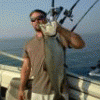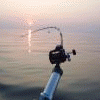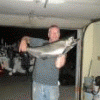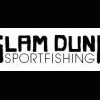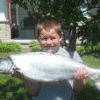-
Posts
200 -
Joined
-
Last visited
BlueCollarOutdoors's Achievements
11
Reputation
-
Sounds like you got it figured out. Dont watch the rod tips bouncing for the most part. If you ever see a rod tip NOT bouncing then you know something is up. Might be dragging around a little guy or have a tangle. If you need to on the TX 22s shift the weight fwd a bit on those boards to make the dig a little more and cut out to the side better. Lots of weight on the back end will make them ride a wheelie and then the angled part of the board is out of the water and will not "cut" the water and push itself out. I never set the long coppers to release just point the rod tip at the board and crank and the board will work its way to the middle of your spread. Then again I never run more than 2 boards a side on my rig so the only thing I am trying to clear over the top of is a dipsy. I set short cores on the outside of spread to trip and center before reeling very aggressively.
-
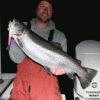
Slide diver rings and weights
BlueCollarOutdoors replied to KJ pluggin's topic in Salmon Pro's Connection
We bought a few at the Mull/Keating seminar in Manty. We were also told 2/1 on these. -
Not a misprint. The spoon was breaking the surface 200 feel back when I finally found some leadcore on the reel. I have no idea why it was so long, no one spoke up when I asked the question. Somehow it got cut down to a reasonable length during the trip and caught 2 fish
-
200 feet was rediculous! By the time I got the 7 color in the water and put the board in a normal position, I had 650 feet of line out just to get a spoon down 30 feet. Then the board tripped 3 lines and slid all the way down to the spoon. Talk about alot of screwing around. Eventually I cut the leader down to under 50, and put a new release on that board and it took 2 fish that night.
-
Agreed, your going to get a lot of answers on that question. Generally I run spoons back 50 to 75, and flashers around 40 feet. The first year I had riggers I ran everything back 75 feet and caught plenty of fish that way as well. We talk about different action of flashers on a different leader length, but have you ever put a flasher on a copper or fullcore? Thats a long leader. Do what works for your spread on your boat. Shorter when learning will help avoid tangles. I have put lures 200 feet behind the DEEPEST rigger in the middle of the day. There is nothing else down there to tangle with so let it back in the no noise, nothing else running water.
-
My copper was at 40 feet all of last season and was a pretty consistent catcher. My cores are 20 to 25 and put plenty of fish in the boat. I was on a boat with a 200 foot leader behind a core last week...
-
Brian is pretty correct with his small amount of gear theory. I have 100 spoons but every trip I grab the 10 I will probably run before hand and put them in a cup holder in the back of the boat. Even then 4 of them will likely see the water. At this point I basically run the same fly on over half of my rigs. Gotta have some backups on board but when you find something that works on your boat and your port letr rip.
-
It can be hard at times. Most tackle has some kind of description right on it now. I have taken pictures of certain flies or flashers and saved them to a folder on my computer. Name the file something like "pk charlies special" and you will know what to look for if you need to duplicate or replace it.
-
Most guys would say the paddle is an 11 inch flasher, and call the 8 inchers a flasher/regular size.
-

Another Copper thread, but this time...
BlueCollarOutdoors replied to UBDSLO1's topic in Salmon Pro's Connection
I'm with Ryan on this one is there depth are anywhere near similar I would gladly run the small diamter 32 to achieve for example 58 feet instead of 66. Trading the lack of depth for being able to double the amount of braid back I have would be a no brainer. I was in the the "fish dont run with long coppers" bandwagon until I almost got spooled by a 22 lb racecar in cold water last weekend. Now I am having second thoughts. Good chatter here as usual. I guess I shoudl just get a 32 and go test it out in shallow and see what it does for myself. -

upgrading the spread.
BlueCollarOutdoors replied to fromtheisland's topic in Salmon Pro's Connection
Literally spreading everything out will help your "fish on" procedure. I run a simple and effective 6 rod spread and we rarely truly tangle anything. I would love to run 2 more boards but I typically only fish with one other guy in the boat. My typical boards are a 250 copper and a fullcore, so adding a 5-7 color and a 2 color for rainbows would not really complicate anything at all. 6 clean rods in the zone off a small boat with an easy to run spread will get you plenty of action. Good luck. -
50 should work for you. Better be careful on turns though or that copper will be in the ground if you turn hard.
-

upgrading the spread.
BlueCollarOutdoors replied to fromtheisland's topic in Salmon Pro's Connection
Do not run the dipseys on planer boards. You want riggers in the back of the boat, then one dipsey per side a couple feet further away from the transom with those rods laid just about flat on each side of the boat. Then run one planer board per side up even further towards the front of the boat. Those rods should stand up tall with the tips just about straight up the in the air. Best picture I can do at the moment. Riggers in back, silver rod holders flat for dipsey on the side and one planer board per side are close to where the camera man is. -

upgrading the spread.
BlueCollarOutdoors replied to fromtheisland's topic in Salmon Pro's Connection
Well I guess a very important question would be what depth do you normally fish and what depth do you catch alot of fish at? I dont know huron well so if your fishing in 75 feet of water and catching fish 40 feet down you have a million options. Dipseys are productive as well and will also get some lures away from the boat instead of having 4 lures all right behind the boat in a clump. A good starting dipsy rig would be a size 30 reel with a counter, spool it up with as much 30 lb mono you can fit and then 50 pound Power Pro 150 yards. A Mag dipsey set on 3, a rubber snubber to absorb the shock of a strike, with a piece of 30 pound mono roughly the length of the rod and then your lure. I have hit bottom in 90 feet of water with this setup going 2.2 mph on the GPS with 275 feet of line out. If your not familar with dipsy diver they have a dial on the back and 0 would run straight behind the boat, number 3L will cut out the the right if your facing out the back of the boat. 3R will cut to the left looking out the back of the boat. Run your dipsy rods about 4 feet forward from your riggers and lay then down flat or close to it. -

upgrading the spread.
BlueCollarOutdoors replied to fromtheisland's topic in Salmon Pro's Connection
Copper is must have to me. The ability to fish deep and away from your other setups added a ton of fish to my boat last year. It especially effect from 7 to 10 am and then again long before sunset when the prime attack anything will reckless abandon bite is off. Your basic copper setup would be a 8'6 okuma copper rod for about 40 bucks and a 45 or 55 size reel. Put as much 50 lb power pro or similar braided line on the biggest reel you can afford first, then add 200 to 300 feet of 45 lb copper and then a 10 to 50 feet leader or 20 lb mono of some heavier flourocarbon. I have a 250 copper on a 45 Okuma Madga with 450 feet of braid backing. I wish it had 900 feet but I put on as much as I could fit on that reel basically. 98 percent of the time fish will not pull out a ton of line do to the weight of the coppe line, but this friday that was tested to the max with a fat 20+ pound king that wanted nothing to do with our boat. I run that copper rig on a TX 44 but others have ran 150 to 300 coppers on the smaller Church walleye boards as well. I would definately add some flashers to your mix, pick up a 8 inch green and glow/silver flasher with a green/glow fly 24-26 inches behind the flasher. Put that on a downrigger about 40 feet back. Even if it doesnt catch you a fish the flash should pull some lookers into your spread and they might grab a spoon while they are in town. Good luck.


